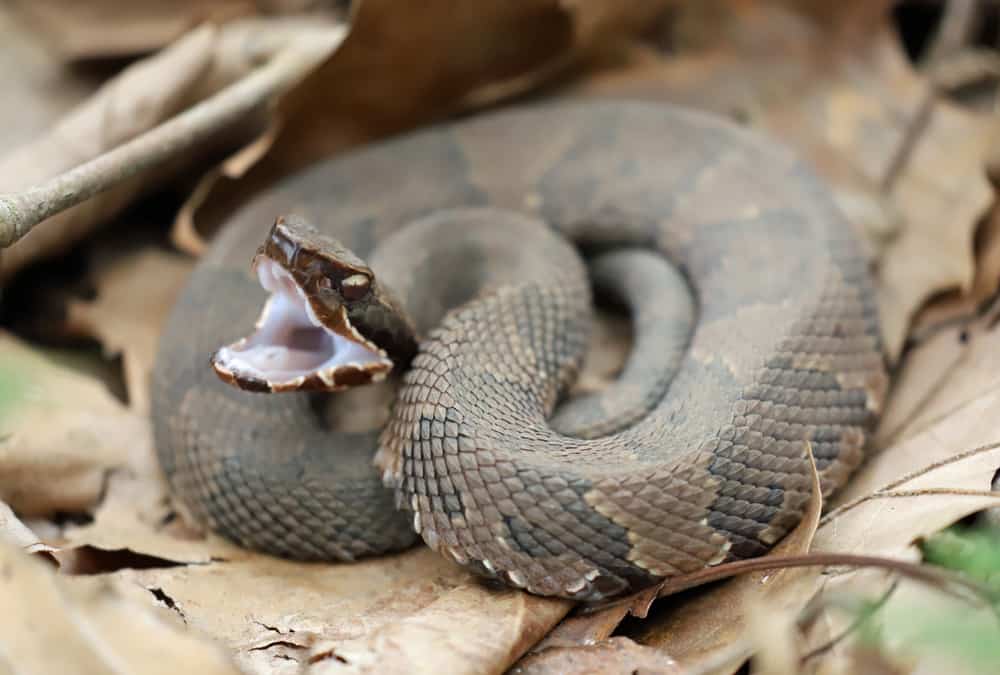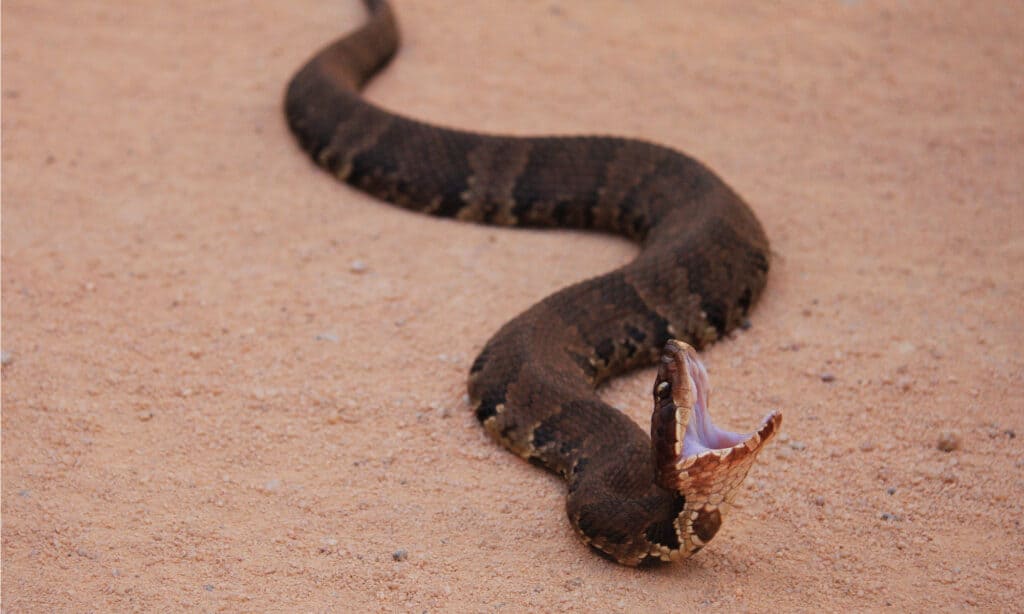As the second largest US state, Texas covers an immense area and features a vast range of habitats for animals to call their home. Snakes are particularly abundant in the state and there are around 96 species, including 14 that are venomous. One such snake is the cottonmouth which is the only semi-aquatic pit viper in the US. In this article we’ll discover everything you need to know about cottonmouths in Texas, including where they live and when they are most active.
About Cottonmouths

Cottonmouths are distinguished by the white lining inside their mouth.
©KF2017/Shutterstock.com
Cottonmouths are one of the best-known venomous snakes in Texas. They’re famed for the white lining on the inside of their mouth which is said to resemble cotton and is the reason that they are named “cottonmouths”. This is most easily visible when the snake adopts a defensive position whereby it coils its body and opens its mouth wide to deter predators.
Cottonmouths are typically 30 to 43 inches long and have heavy bodies. They have a dark brown ground color overlaid with a series of black crossbands. Sometimes cottonmouths can have a very dark ground color which means that the entire snake appears to be almost completely black. However, juvenile cottonmouths look very different. Instead of being dark-colored they have tan bodies which are overlaid with reddish brown crossband markings. They also have a bright yellow tip on their tail.
Although cottonmouths are widespread across the southeastern region of the US there are actually now two different species of these snakes. Originally, there was only one single species, but in 2015 the Florida subspecies was reclassified as it’s own species. The other two former subspecies were also then reclassified as the northern cottonmouth (Agkistrodon piscivorus). The northern cottonmouth is the species that is found in Texas. However, for ease we’ll continue to refer to them as cottonmouths for the rest of the article.
Where Are the Cottonmouths in Texas?
Cottonmouths are semi-aquatic snakes and commonly called “water moccasins”. They rarely stray far from water and inhabit freshwater locations such as lakes, rivers, swamps, ponds, and ditches. However, they only occur in the eastern region of the state.
Although cottonmouths also prey on small mammals, they do rely heavily on the water as their source of food. They prey upon a wide range of fish, frogs, and even small water birds. Cottonmouths typically swim near the surface of the water with their body often appearing to be on the water instead of being completely submerged. They also swim with their head held fairly high which gives them a distinctive appearance.
Cottonmouths share their range with several other water snakes. Many of these snakes have a similar appearance to cottonmouths and are often mistaken for them. Although these snakes are not venomous they are sometimes killed as a result of mistaken identity. Common water snakes across Texas include the northern water snake, southern water snake, and the diamondback water snake.
When Are Texas Cottonmouths Most Active?

Texas cottonmouths are most active between April and October.
©Nathan A Shepard/Shutterstock.com
Cottonmouths are nocturnal so they are most active during the night. However, cottonmouths are typically only active between the months of April and October as the winter is spent in a state of brumation. During this time they will hide away in a rock crevice or den — often with other snakes — until the cold weather passes. Despite this, they may still be observed basking outside on warm afternoons.
Cottonmouths mate in the spring and give birth between August and October. They are ovoviviparous so the female retains the eggs inside her body until they are ready to hatch — eventually giving birth to live young. Litters can consist of anything between three and 12 juveniles. The young are six to 11 inches long and are born with fully functional fangs and a venom supply.
How Dangerous are Cottonmouths?
As we mentioned earlier, cottonmouths are venomous snakes. They possess cytotoxic venom which can cause tissue damage or necrosis (tissue death). Bites from these snakes tend to cause serious scarring of the affected limb, although sometimes the damage can be so severe that amputation is required.
Cottonmouths also have a high venom yield and inject approximately 125mg of venom per bite. The estimated fatal dose for a human is 100 to 150mg. However, cottonmouths are not the most deadly snake in the US. There are approximately 8,000 snake bites in the US every year with an average of five deaths. Cottonmouths are responsible for only 1% of these bites, although this figure rises to 7.3% across their known range. Records of snake bites in Texas suggest that cottonmouths are responsible for 7% of bites in the state, and the odds of them being fatal remain low.
What to Do if You See a Cottonmouth

If you see a cottonmouth then back away slowly and allow it to return to the water.
©jo Crebbin/Shutterstock.com
Most snake bites occur when the snake is disturbed, threatened, or stood on. This means that you should always take care to watch where you step. You should also avoid putting your hands into crevices or underneath logs. Obviously, as cottonmouths inhabit wetland habitats, you should take care near water too.
If you do come across a cottonmouth then it’s important to remain calm. Research suggests that 50% of cottonmouths prefer to flee when they are disturbed rather than stand their ground. The main place that these snakes will want to head is back to the water for safety. Therefore, you should back away slowly and give the snake room to escape.
If the snake does bite you then the important thing is to seek medical attention immediately. Cottonmouth bites are typically less severe if anti-venom is administered within one hour. The initial symptoms of a bite are burning pain and swelling of the affected area. Although you may be tempted to try and remove the venom yourself you should never do this as it can make things worse. Instead, remain calm while you wait for help.
The photo featured at the top of this post is © Psychotic Nature/Shutterstock.com
Discover the "Monster" Snake 5X Bigger than an Anaconda
Every day A-Z Animals sends out some of the most incredible facts in the world from our free newsletter. Want to discover the 10 most beautiful snakes in the world, a "snake island" where you're never more than 3 feet from danger, or a "monster" snake 5X larger than an anaconda? Then sign up right now and you'll start receiving our daily newsletter absolutely free.
Thank you for reading! Have some feedback for us? Contact the AZ Animals editorial team.






